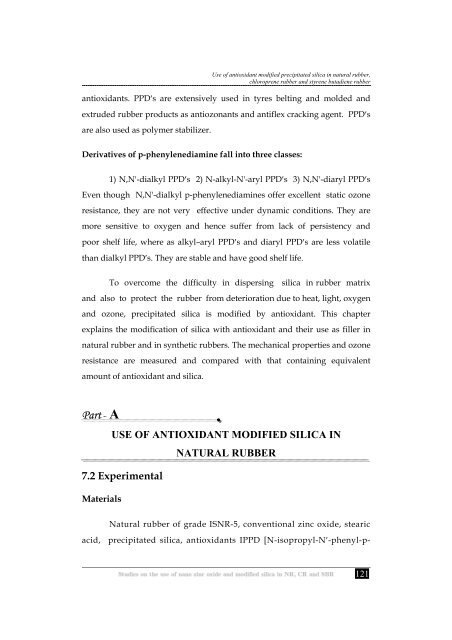Studies on the use of nano zinc oxide and modified silica in NR, CR ...
Studies on the use of nano zinc oxide and modified silica in NR, CR ...
Studies on the use of nano zinc oxide and modified silica in NR, CR ...
Create successful ePaper yourself
Turn your PDF publications into a flip-book with our unique Google optimized e-Paper software.
Use <strong>of</strong> antioxidant <strong>modified</strong> precipitated <strong>silica</strong> <strong>in</strong> natural rubber,<br />
chloroprene rubber <strong>and</strong> styrene butadiene rubber<br />
antioxidants. PPD′s are extensively <strong>use</strong>d <strong>in</strong> tyres belt<strong>in</strong>g <strong>and</strong> molded <strong>and</strong><br />
extruded rubber products as antioz<strong>on</strong>ants <strong>and</strong> antiflex crack<strong>in</strong>g agent. PPD′s<br />
are also <strong>use</strong>d as polymer stabilizer.<br />
Derivatives <strong>of</strong> p-phenylenediam<strong>in</strong>e fall <strong>in</strong>to three classes:<br />
1) N,N'-dialkyl PPD′s 2) N-alkyl-N'-aryl PPD′s 3) N,N'-diaryl PPD′s<br />
Even though N,N'-dialkyl p-phenylenediam<strong>in</strong>es <strong>of</strong>fer excellent static oz<strong>on</strong>e<br />
resistance, <strong>the</strong>y are not very effective under dynamic c<strong>on</strong>diti<strong>on</strong>s. They are<br />
more sensitive to oxygen <strong>and</strong> hence suffer from lack <strong>of</strong> persistency <strong>and</strong><br />
poor shelf life, where as alkyl–aryl PPD′s <strong>and</strong> diaryl PPD′s are less volatile<br />
than dialkyl PPD′s. They are stable <strong>and</strong> have good shelf life.<br />
To overcome <strong>the</strong> difficulty <strong>in</strong> dispers<strong>in</strong>g <strong>silica</strong> <strong>in</strong> rubber matrix<br />
<strong>and</strong> also to protect <strong>the</strong> rubber from deteriorati<strong>on</strong> due to heat, light, oxygen<br />
<strong>and</strong> oz<strong>on</strong>e, precipitated <strong>silica</strong> is <strong>modified</strong> by antioxidant. This chapter<br />
expla<strong>in</strong>s <strong>the</strong> modificati<strong>on</strong> <strong>of</strong> <strong>silica</strong> with antioxidant <strong>and</strong> <strong>the</strong>ir <strong>use</strong> as filler <strong>in</strong><br />
natural rubber <strong>and</strong> <strong>in</strong> syn<strong>the</strong>tic rubbers. The mechanical properties <strong>and</strong> oz<strong>on</strong>e<br />
resistance are measured <strong>and</strong> compared with that c<strong>on</strong>ta<strong>in</strong><strong>in</strong>g equivalent<br />
amount <strong>of</strong> antioxidant <strong>and</strong> <strong>silica</strong>.<br />
Part@ A<br />
USE OF ANTIOXIDANT MODIFIED SILICA IN<br />
7.2 Experimental<br />
Materials<br />
NATURAL RUBBER<br />
Natural rubber <strong>of</strong> grade IS<strong>NR</strong>-5, c<strong>on</strong>venti<strong>on</strong>al <strong>z<strong>in</strong>c</strong> <strong>oxide</strong>, stearic<br />
acid, precipitated <strong>silica</strong>, antioxidants IPPD [N-isopropyl-N′-phenyl-p-<br />
121

















